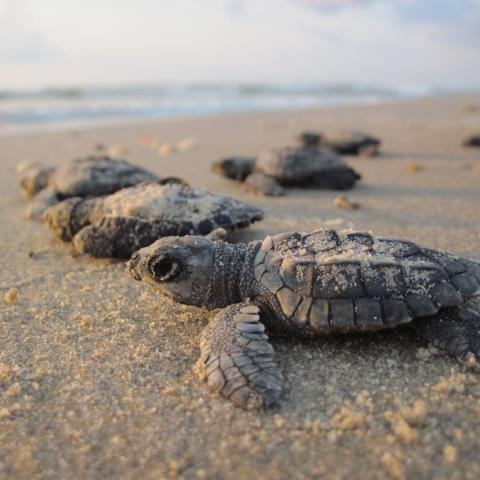
Watch for rip currents this summer at national seashores and national lakeshores/NPS file
Frequent national park visitors are often aware of potential dangers such as wild animals, hot weather, and getting lost on hiking trails. But ahead of the busy summer season, park officials at national seashores and national lakeshores are warning of something that might not be as familiar: Rip currents.
Rip currents are fast-moving channels of water that flow away from the beach. The National Weather Service notes they can reach speeds up to 8 feet per second, which is faster than an Olympic swimmer.
"Their strength can pull even the strongest swimmers away from the beach, making it difficult to return to shore," said Mike Barber, a spokesperson for national park sites on North Carolina's Outer Banks.
The region includes Cape Hatteras National Seashore, where a 68-year-old man died in dangerous surf and rip current conditions in September 2023. He was one of 192 people killed in rip currents in the Carolinas from 2000 to 2024.
Overall, the United States Lifesaving Association estimates more than 100 people die in rip currents nationwide each year, and rescuing people from them accounts for about 80 percent of beach surf rescues.
Most recently, two people were rescued from rip currents at Cape Canaveral National Seashore in Florida. The incident on April 27 was captured in dramatic body cam footage that showed NPS law enforcement personnel administering life-saving first aid to one of the victims.
It's important to note that rip currents aren't just in the ocean. They can happen on beaches with surf, including the Great Lakes. Lake Michigan has recorded more than 250 cases of swimmers caught in rip currents since 2002, according to Indiana Dunes National Park.
Other sites to watch for them include Gulf Islands National Seashore, Cape Cod National Seashore, Cape Lookout National Seashore, Pictured Rocks National Lakeshore, Assateague Island National Seashore, Fire Island National Seashore, Point Reyes National Seashore, Padre Island National Seashore, Indiana Dunes National Park, and Sleeping Bear Dunes National Lakeshore.
How To Spot A Rip Current
Rip currents happen any time of the year, even on days that appear perfect for swimming. Rip currents can be hard to see from the beach but here are some clues to watch for, courtesy of the weather service and the United States Lifesaving Association:
- A narrow gap of darker water that might seem calmer than areas on either side of it
- A channel of choppy, churning water
- Differences in water color
- A line of foam, seaweed or beach debris flowing out to sea
- They can be more common and intense in sandbars and near inlets, jetties, and piers.
How To Stay Safe At The Beach
The best way to protect yourself is to go in the water only where lifeguards are present.
"Lifeguarded beaches are the safety places to swim at Cape Hatteras National Seashore," Barber said, adding there are five lifeguarded locations there open from Memorial Day weekend through Labor Day.
Also pay attention to beach flags and know what they mean. A red flag should be considered a warning not to swim.
Here are more tips from the National Park Service and other sources:
- Swim with something that floats, like a boogie board or inflatable ring.
- Check beach conditions before you go. Beaches and parks will often post on their websites or social media, and the National Weather Service posts surf zone forecasts online by region.
- Sign up for local text alerts, where available. In the Outer Banks, you can do that by texting OBXBeachConditions to 77295, Barber said.
- Never swim alone.
- If in a group, take turns staying on shore to keep an eye on those in the water.
- Know your physical limits.
What To Do If You're Caught In A Rip Current
If you feel yourself being swept away from the beach, don't panic and don't fight it.
If you can, swim parallel to the shore until you are out of the current and can slowly work your way back to shore. If you can't do that, float calmly on the current until it releases you. If possible, signal for help by yelling or waving.




 Support Essential Coverage of Essential Places
Support Essential Coverage of Essential Places






